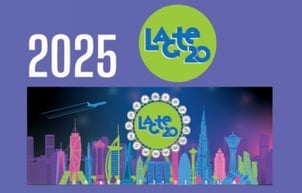In an era of globalization, business communication is reaching across international borders, geographic locations and time zones, and getting closer to barrier-free communication than ever.
As more events leverage digital technologies and hybrid formats, it’s increasingly easy for interested parties to participate in seminars, conferences, meetings, and the like — all in their chosen language. Ultimately ensuring multilingual communication doesn't get interrupted by language barriers.
And it’s all thanks to talents and technologies that allow for translation, interpretation (both simultaneous and consecutive), captioning, and subtitling to take place virtually and manifest locally.
Across the globe, these technologies are transforming how content is delivered and bridging communication gaps. They are enabling greater collaboration, supporting more opportunities to spread knowledge, helping people to pursue new business opportunities, and allowing us all to embrace other cultures.
It’s important to note that these processes all operate independently and are not interchangeable — so getting the most out of them means understanding how each one works and their best use-case scenarios.
In this article, we’re going to look at the differences between translation, interpretation, subtitles, and captioning, and where their best use case is.
Translation
Though often used interchangeably, translation and interpretation are very different disciplines.
Translation is about conveying the meaning of the written word from one language to another. For example, a book publisher might ask a translator to translate the contents of a book from one language (let’s say English) to another (Japanese).
It’s a translator's job to capture the content, style, tone, and form of the original text accurately and then render it into the target language in writing.
Another type of translation is machine translation (MT), where software, or artificial intelligence (AI), turns text in one language into another language. Unlike professional translations though, machine translations don’t have the ability to consider context or tone because of their word-for-word nature.
Interpretation
Interpretation, on the other hand, is about conveying the meaning of spoken or signed words from one language to another, so that audiences can understand what’s being said.
Compared to translation, interpretation is a much more immediate process with no time for second-guessing or wordsmithing. Interpreters must understand, digest, and relay messages to audiences in another language in spoken or signed form. With simultaneous interpretation, this process is performed in real-time — at the pace of the speaker, meaning the interpreter must listen to the source language and speak to the target audience at the same time.
Captioning
Captioning is the process of converting audio content (of a television broadcast, film, video, live event, or other production) into text as transcription and displaying that text on a screen, monitor, or other visual display. Captions are designed to provide a visual aid to follow the audio content with visual reinforcement. Especially useful for people with hearing impairment, captions are also popular to watch content while in a noisy environment.
The captions are synchronized with the audio so that they appear as the audio is delivered. There are different methods to create captions: offline, if they are created and added after a video segment has been recorded and before it is aired or played, or online, when they are created in real-time, at the time of program origination.
Captions must have the capability to be turned on for those who need them and off in case they are not needed.
Types of captions:
- Closed Captions (CC): This captions type provides users with the capability to activate when they need them and deactivate if they’re not required.
- Open Captions: These are different from Closed Captions in that they are part of the video itself and cannot be turned off.
Types of multilingual captions:
Captions can also cater to multilingual audiences by making the speech available as live transcriptions in other languages than the speakers':
- Human-interpreted live captions: With Live Captions such as Interprefy Captions, the audio speech is rendered into another language by a professional conference interpreter. Automated Speech Recognition (ASR) technology, powered by Artificial Intelligence( AI), then transcribes it into written text that appears in the video - in real time.
- Human captioning: Captioners, or often also referred to as Captionists, can transcribe spoken words into text by listening to the speech and typing simultaneously.
- Machine-translated AI captions: Much like the above, ASR technology is transcribing the speech live but is then rendering the text into another written language through machine translation.
Subtitles
Captions and subtitles overlap in many ways but are distinct in their purpose. While captions are designed to support the hard of hearing, subtitles are translations for people who don’t speak the language of the medium. They are often used for movies and tv shows and are typically developed before the release of a film or show.
Standard subtitles are designed for viewers who hear the audio but cannot understand it. However, there is a type of subtitle specifically designed to support hearing-impaired individuals: Subtitles for the Deaf and Hard of Hearing (SDHH). SDHH contains not only the spoken dialogue but information about background sounds and speaker changes, along with a translation of the script.
Use-case scenarios: Translation
Translation, interpretation, and captioning all have their advantages and disadvantages — but what’s more important is using them in the right contexts.
For example, if your seminar, meeting, or conference documentation (i.e. brochure, itinerary) is in English but some of your registered attendees only speak German, you’ll need to have that content translated for them to read. Not only does this improve accessibility and inclusion, it also improves brand sentiment and recognition as attendees will recognize the effort you’ve put in to help them.
Use-case scenarios: Simultaneous and consecutive interpretation
What about interpretation? Well, let’s say you’re hosting a hybrid event that requires information to be distilled and conveyed quickly in another language. There are two options here: simultaneous or consecutive interpretation.
- Simultaneous Interpretation: As mentioned above, simultaneous interpretation takes place in real-time, with the interpreter converting a speaker’s words and meaning into another language as that speaker is talking. The interpreter will be listening to the speaker via headphones and interpreting into a microphone for the audience. This kind of method of interpretation is indispensable when the delay in the delivery of the speech could ruin the experience of the event. Simultaneous interpretation really shines in situations where one person (or a panel) is speaking to an audience. Think diplomatic conferences, international conventions, courtrooms, lectures and presentations, press conferences, and so on.
Advancements in technology have also made it possible for simultaneous interpretation to be performed remotely. Thanks to remote simultaneous interpretation (RSI) solutions, interpreters can work from anywhere and event organizers can bridge the language gap while connecting to a wider audience that can also attend in person or remotely. You can find out more about how simultaneous interpretation works by clicking here. - Consecutive Interpretation: Consecutive interpretation takes place when a speaker makes a speech or says a few sentences and pauses to allow the interpreter to convey their most recent statement to the target audience before proceeding. The interpreter usually sits or stands next to the speaker — taking notes as the speaker talks — to help relay everything clearly. This method is typically used for small meetings/events, one-to-one conversations, court depositions, and much more as it has the advantage of being more like a conversation, with both parties being able to speak uninterrupted.
Whether you engage the interpreter in simultaneous or consecutive interpretation, the interpreter should understand the subject matter so providing them with information and supporting documents is essential so they can prepare well.
Use-case scenarios: Captioning
Captions are increasingly popular for live events, such as webinars, presentations, or conferences, providing a visual aid to follow the speech.
Some might have difficulty hearing — so adding captions makes it easy for them to read what’s being said. Others might prefer reading over listening because they might be in a noisy environment such as a café or on public transport.
Captions make it easier to catch and keep your audience’s attention. It’s much easier to follow what’s going on (and validate what’s being said) if captions are enabled.
Use-case scenarios: Subtitles
Because subtitles are designed for people who can hear the audio but don't understand it, they are mainly used in movies and TV series amongst those who like watching content in its original version but cannot understand it. Also, they are produced and synchronized before the video is released and most on-demand video streaming platforms include them.
Bridging the language gap with the right process and technology
Simultaneous interpretation —on-site or remote—, translation, captioning and subtitles all fulfil the purpose of bringing down language barriers. Deciding which one to use depends mainly on your type of content and user needs.
When it comes to deciding on the technology, besides content type and user needs, setting and budget also play a key role. There are services that event managers can use to get access to interpreters and human-interpreted live captions in virtual and hybrid setups. Platforms such as Interprefy enable real-time simultaneous interpretation and live captioning on any event type and meeting empowering event managers to deliver content in a variety of languages. 




 More download links
More download links



